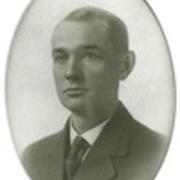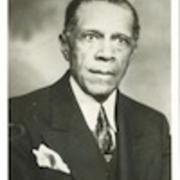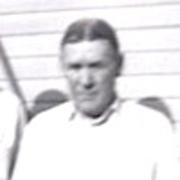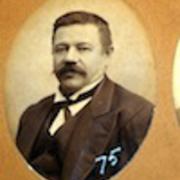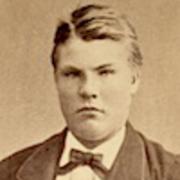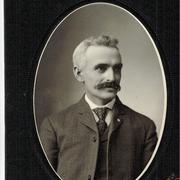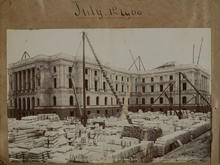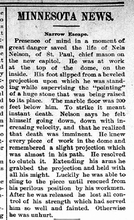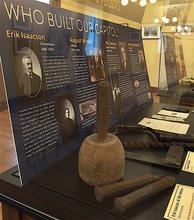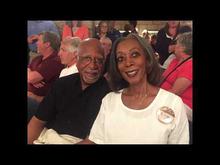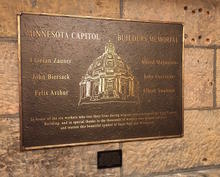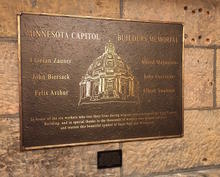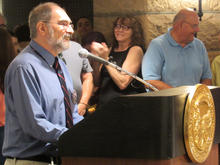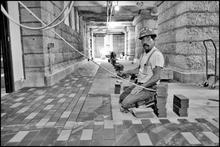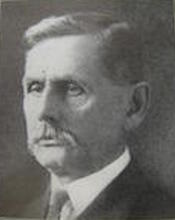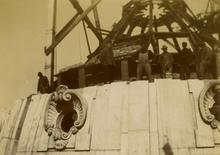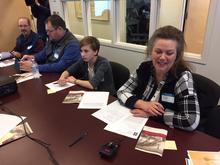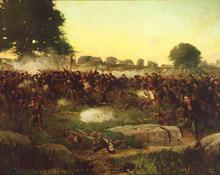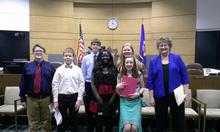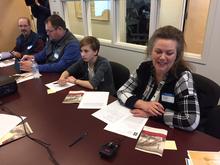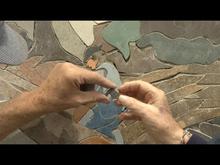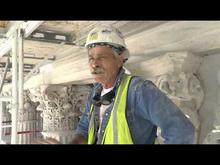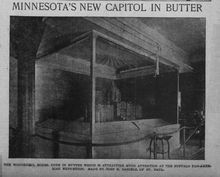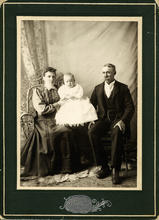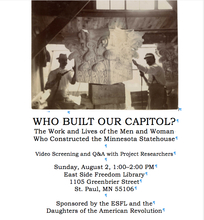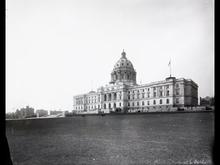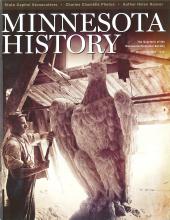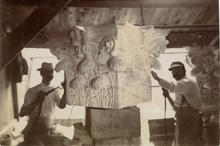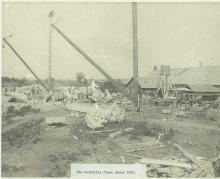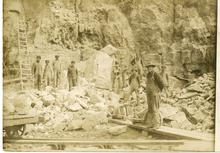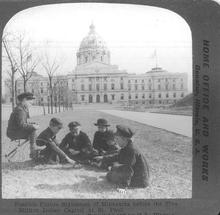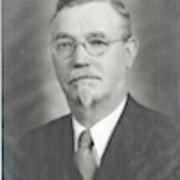
News
MNopedia published an article on the workers who were killed during the construction of the Minnesota State Capitol.
MinnPost and Minnesota Local History featured the article as a pick-of-the-week.
The piece was researched and written by Who Built Our Capitol? project team members Randy Croce, David Riehle, John Sielaff and Victoria Woodcock.
Stonemason Nils Nelson's Narrow Escape
A two-part exhibit opened at the Minnesota State Capitol this week. One section focuses on the role of women in constructing the Capitol. The other shows tools and objects made and used by the original tradespeople who built the statehouse. The display grew out of the LES “Who Built Our Capitol?” project that uncovered more than 620 of the original builders from1896-1905.
A simple question, “Who were the workers who built the Minnesota State Capitol?” was the catalyst for efforts leading to the dedication of a commemorative plaque during Sunday’s grand opening of the newly restored building. More than 300 people attended ceremonies to recognize the original builders of the statehouse and those involved in recent renovations.
State Capitol shines anew
Festivities celebrate renovation, acknowledge workers past, present
ST. PAUL — With three days of festivities August 11-13, Minnesota celebrated the grand re-opening of the newly-restored State Capitol building.
ST. PAUL — The basement L’Etoile du Nord Vault Room at the Minnesota State Capitol was standing-room-only August 13, a day set aside to honor the workers who helped renovate the building and to also honor the capitol’s original builders, including six workers who died during the 1896-1907 construction.
An exhibit of photographs by Tom Olmsheid portraying tradespeople who worked on the recent restoration of the Capitol is on at exhibit in the newly opened building's basement. The black and white images of trades men and women give a sense of the diversity of jobs and workers on the project. These skilled workers brought the statehouse back to the beauty of its 1905 appearance, while modernizing it for use in the 21st century. The pictures of workers, composed to show the jobs they do, also give a sense of their individual personalities as they look back at Olmscheid and at those who ar
Two Canadian historical researchers met with Who Built Our Capitol project director Randy Croce and researcher John Sielaff at the University of Minnesota on March 30 to share information on French Canadian stone artisans who worked on the construction of the Minnesota State Capitol.
Minnesota State Capitol construction workers will be honored as part of the Grand Opening of the newly restored building on Sunday, August 13. At 2:30 p.m. by the basement L’Etoile du Nord Vault (Room B-15), a plaque will be dedicated to memorialize workers who built the statehouse, especially the six who died in the original construction. These workers and more than 620 others were identified by researchers for the Labor Education Servicer project, “Who Built Our Capitol?”
Workday Minnesota article by Barb Kucera
After more than 100 years, the workers who built the Minnesota State Capitol, including six who were killed in the construction, will be honored in the statehouse. On Dec.15, a jury met to select designs for a commemorative plaque from among more than 50 entries submitted by sixth graders across the state.
The Who Built Our Capitol? documentary was cited in a letter to the editor by project researcher David Riehle on the controversy over display of Civil War battle paintings in the Governor's Reception Room. (Minneapolis StarTribune, December 2, 2016, page A8)
STATE CAPITOL ART
Here is some better context for the ‘Civil War paintings’ debate
ST. PAUL - After more than a hundred years, the workers who built the Capitol, including six who were killed in the construction, will be honored in the statehouse. On December 15, 2016, a jury met to select designs for a commemorative plaque from more than 50 entries submitted by sixth graders across the state.
The creators of the two designs which will be used to create the memorial will be announced the week of December 19, 2016.
State Capitol Commemorative Plaque Design Competition – Deadline Extended to December 8
In Owatonna,MN, Willow Creek Intermediate School sixth graders wanted to know why there was no recognition of the workers who built the Minnesota State Capitol anywhere in the buidling. They had been studying the builders with their teacher, Jen Hansen, co-designer of the "Who Built Our Capitol?" curriculum featured on this website.
On Memorial Day, 2016, a newly-created mosaic mural was dedicated at the Minnesota Workers Memorial Garden on the Capitol grounds. The images of workers from a myriad of occupations were created by public artist Craig David using pieces he cut from porcelaine floor tiles. The memorial recognizes the efforts of all workers in building the state of Minnesota, particularly those who gave their lives on the job. The six workers who died in accidents during the Capitol construction between 1998 and 1903 were recognized at this wall during Workers Memorial Day ceremonies in 2011 and 2012. Dav
Contemporary stonecutters restore original carvers' marble ornamentation on the exterior of the Capitol.
A new Educators page on the Minnesota State Capitol Restoration Project website prominently features content from this website and many links to it.
Project researcher Dave Riehle came across this photo and caption from the Minneapolis Journal in 1901.
Familes of the workers and contractors who built the Minnesota State Capitol continue to provide the project with new information on their ancestors.
The Who Built Our Capitol? curriculum was presented in a workshop at the Minnesota Educator Academy (MEA) at 8:30am on Thursday, October 15 in Room 12 at the Saint Paul RiverCentre. LES project director Randy Croce and Jen Hansen, the Owatonna Willow Creek Intermediate School teacher who co-developed the lessons, shared the background of the project, demonstrate the classes and showed a portion of the video documentary. Free copies of the video DVD were given to par
The Daughters of the American Revolution (DAR) and the East Side Freedom Library (ESFL) are hosting a screening of the documentary, Who Built Our Capitol?, about the men and women who constructed the Minnesota statehouse. Randy Croce and John Sielaff, members of the research team, will be present to talk about the project and answer questions.
To learn about the latest restoration work on the Capitol building as well as the history of the project, see the Minnesota Department of Administration website.
Project researcher John Sielaff discovered another accidental death connected to the Minnesota Capitol building construction. William Platenberg was fatally injured while he was working in the Baxter quarry, just west of St. Cloud, on April 7, 1898. This quarry was supplying the granite for the base of the statehouse at that time, so it is likely that the stone Platenberg was splitting was destined to be used in the construction in St.
The Who Built Our Capitol? website and documentary project won the American Association for State and Local History media award. This national award was presented at the AASLH national convention in St. Paul, MN on September 19, 2014. AASLH website for more information on the organization and awards. The video also took first place in the documentary competion of the International Labor Communications Association (ILCA) 204 Labor Media Awards.
The Capitol project will be featured during the 11 to noon hour, Monday, January 26 on the "Daily Circuit," Minnesota Public Radio, 91.1 FM in an interview by Tom Weber with project director Randy Croce. See the MPR website, http://www.mprnews.org/story/2015/01/26/daily-circuit-who-built-the-capitol An audio recording of the interview can be found on this web page.
Closed Captioning is now available for viewing the documentary video. Just click the CC icon at the lower right hand corner of the video window after the show begins playing, then click "on."
John Kaul has produced a new documentaty about the current restoration of the Minnesota State Capitol Building. The video, titled Resurrection, presents the current work to save the deterorating physical structure of the building and to bring electrical, Wi-Fi and other systems up-to-date. Interviews also relate the condition of the structure, as well as moved offices and other accomodations necessary until the major construction project is completed in 2016.
Who Built Our Capitol? project researcher John Sielaff was interviewed by Allison Herrera for an MN90 radio (Minnesota History in 90 Seconds) segment about the stonecutters who worked on the Minnesota State Capitol building. Master stone carver and Bricklayers and Allied Craftworkers Local 1 member Mark Wickstrom, profiled in a video on this website, is also featured in the story.
The curriculum developed to teach social studies concepts will be presented at the annual Minnesota Council on the Social Studies Conference on Monday, February 23 at the Earle Brown Heritage Center in Brokklyn Park. Curriculum co-designers Jen Hansen (Owatonna) and Missy Klapperich (Cannon Falls) with project director Randy Crocewill talk with educators at the presentation on the project and the curriculum in the poster session area between 1 and 3:30 pm.
The Spring 2014 issue of Minnesota History Magazine featured a cover story by project researcher John Sielaff on the stonecutters who worked on the Minnesota Capitol building .
The State Law Library will host a special screening of the documentary Who Built Our Capitol? at the Minnesota Justice Center on February 4. This film tells the story of the workers who came from across the state and country to build our statehouse. Film-maker Randy Croce will be present to talk about the making of the documentary. Marvin Anderson, former State Law Librarian, will also join us to talk about his grandfather, Ernest Jones, who is one of the workers featured in the film. The program will run from noon to 1:00pm in room 230. Seating will be first come, first seated.
History Lounge: Who Built Our Capitol?
Minnesota History Center, St. Paul MN
Dates: Jan. 27, 2015
Time: 7 p.m.
Fee: Free
Teachers in grades 6-12 are invited to register for a one-hour Sources and Scholars program featuring primary sources and classroom ideas, and then attend the free History Lounge, for two hours of learning!
More information and registration at http://education.mnhs.org/sources-and-scholars-who-built-our-capitol
The Who Built Our Capitol? documentary will be broadcast by Twin Cities Public Television (TPT) Channel 2-2 on October 26 at 8 PM on the TPT Minnesota Channel throughout Minnesota.
Presentation on the research for this website and the documentary, followed by a tour of the Capitol building, starting in Room 25 from 1 to 3:30 pm on Saturday, Oct. 25.
WJON AM 1240 will broadcast a radio interview with Capitol project director Randy Croce and host Jim Maurice on Thursday, October 23 in the St. Cloud area. The full interview will air at noon, with excerpts broadcast throughout the day. You can listen online.
(Photo of Rockville Granite plant circa 1900, courtesy of Stearns County History Museum)
Who Built Our Capitol? will was shown at the Stearns County History Museum at 9 am on October 8. Members: free/Non-members: $7
Granite from the area was used for the base of the Minnesota State Capitol and throughout the building.
The video's producer, Randy Croce, introduced the video and answered questions at the screening. Over 100 people attended the event.
The Who Built Our Capitol? documentary will be broadcast by Twin Cities Public Television (TPT) on Labor Day, September 1st. The program will air at 2 AM, 8 AM, 2 PM and 8 PM on the TPT Minnesota Channel throughout Minnesota. Check the chart below to find the tpt MN station number on the air (2-2) or via cable providers.
Who Built Our Capitol? will be shown at 7 pm on April 24, 2014 at the Winona Historical Society. Video producer Randy Croce and researchers John Sielaff and Dan Ganley will be present to introduce the documentary and discuss it with the audience. The society, as well as the county recorder's office, provided many photographs, maps and information to the project on the locally quarried limestone that was used throughout the interior of the Minnesota Stae Capitol.
The website now contains 2 versions of the Emmett Butler Memoir-an edited version and now an earlier, unedited version. To see both click here.
Curriculum co-developer Jan Hansen and project director Randy Croce will conductt a workshop at the annual Minnesota Council for the Social Studies Conference. The presentation takes place at 1:10 pm in the Atwood Center, St. Cloud State University on Monday, March 7, 2016.
